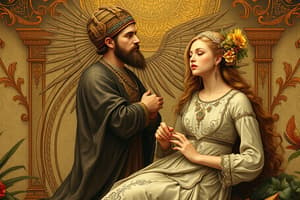Podcast
Questions and Answers
What did Leonardo Da Vinci write about?
What did Leonardo Da Vinci write about?
the importance of introducing random and chance events to produce variation in one's thinking patterns
Where does Da Vinci think you could find inspiration for new ideas?
Where does Da Vinci think you could find inspiration for new ideas?
look for random subjects to conceptually blend with your challenge
What does your mind do when nonsense is thrown at it?
What does your mind do when nonsense is thrown at it?
make sense of it
Did Leonardo have any book knowledge?
Did Leonardo have any book knowledge?
What did Da Vinci appreciate regarding air and water?
What did Da Vinci appreciate regarding air and water?
What habit about connections should you make?
What habit about connections should you make?
What is something that the human brain cannot do?
What is something that the human brain cannot do?
When an apple fell on Newton's head, what else did he realize?
When an apple fell on Newton's head, what else did he realize?
What is Rite-Solutions?
What is Rite-Solutions?
What did an employee try to help after recognizing similarities in core technologies?
What did an employee try to help after recognizing similarities in core technologies?
What was Mark Martinez concerned about?
What was Mark Martinez concerned about?
Summarize Clive Thompson's statement.
Summarize Clive Thompson's statement.
Blending concepts is a way of...
Blending concepts is a way of...
What does the blend develop consciously and unconsciously?
What does the blend develop consciously and unconsciously?
What did Max Planck create?
What did Max Planck create?
What are sources of unrelated stimuli?
What are sources of unrelated stimuli?
What is a human genius?
What is a human genius?
What is SOLVE?
What is SOLVE?
What is an original idea?
What is an original idea?
What observation did physicist David Bohm make?
What observation did physicist David Bohm make?
How do your thoughts exist?
How do your thoughts exist?
What was Thomas Edison's lab like and why?
What was Thomas Edison's lab like and why?
What should you do to help your problems when you come up with ideas that work for other problems?
What should you do to help your problems when you come up with ideas that work for other problems?
What happens when your thoughts build up and reach a critical point?
What happens when your thoughts build up and reach a critical point?
What kind of process is perception?
What kind of process is perception?
How can you catalyze creative thinking?
How can you catalyze creative thinking?
Flashcards are hidden until you start studying
Study Notes
Leonardo Da Vinci's Insights on Creativity and Thinking
- Introduced the significance of randomness and chance events in enhancing thought processes.
- Suggested seeking inspiration by blending random subjects with existing challenges to spark new ideas.
- Highlighted the mind's innate ability to interpret and derive meaning from nonsensical information.
Da Vinci's Knowledge and Perceptions
- Had minimal formal book knowledge, relying heavily on observation and experience.
- Recognized the relationship between air and water, showcasing early understanding of fluid dynamics.
Connection and Concentration
- Urged the importance of exploring diverse domains for connecting ideas relevant to one's subject.
- Noted the brain's limitation in simultaneously concentrating on multiple distinct thoughts.
Historical Insights and Innovations
- Newton's apple fall led to the realization of universal gravitational laws affecting the moon's orbit.
- Introduced Rite-Solutions, merging stock exchange principles with an internal idea exchange system.
Education and Energy Awareness
- An employee recognized the similarity between core technologies and military algorithms, underscoring the role of education in harnessing tech.
- Mark Martinez from Southern California Edison expressed concern about the invisibility of energy and its societal implications.
Social Media and Energy Use
- Clive Thompson posited that public visibility of energy consumption would reduce overall usage.
Blending Concepts and Innovation
- Blending unrelated ideas occurs naturally, facilitating deeper, subconscious thinking.
- This process produces emergent meanings, constructing new ideas beyond initial inputs.
Contributions to Science and Understanding Reality
- Max Planck developed quantum theory, revolutionizing scientific thought.
- Identified unrelated stimuli, such as images and illustrations, as sources for creative inspiration.
The Nature of Genius and Creativity
- Human genius characterized by complex imagination and the generation of novel connections.
- SOLVE is a service connecting subscribers to expertise via phone consultations.
Original Ideas and Perception
- Defined original ideas as interpretations that transcend the sum of their parts.
- David Bohm observed a multitude of existence states, published in "Quantum Theory" in 1951.
Evolution of Thought and Problem-Solving
- Thoughts exist in various states within both conscious and subconscious realms.
- Thomas Edison’s laboratory design facilitated project rethinking and constant innovation.
- When ideas accumulate, they can self-organize into innovative concepts.
Active Perception and Creative Thinking
- Perception is an active process, indicating constant engagement with information.
- Promoted creative thinking by encouraging examination of subjects from multiple perspectives, termed "saper vedere" or "knowing how to see."
Studying That Suits You
Use AI to generate personalized quizzes and flashcards to suit your learning preferences.




